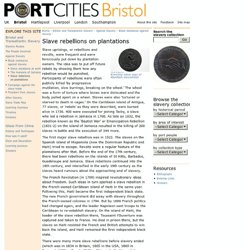

Haiti. The island of Hispaniola, which is today shared by the Dominican Republic to the east and Haiti to the west, was the first permanent European settlement in the Americas.

Sugar and slaves Sixty years after Christopher Columbus's arrival there in 1492, the indigenous population had been reduced from 600,000 to 500 due to harsh treatment and European diseases. The demand for labour led to the introduction of enslaved Africans to work the island's mines and plantations. By the end of the 18th century, St Domingue was a French colony, occupying the western half of the island and accounting for two thirds of France's overseas trade. Sugar was the most important crop. The remaining 70,000 people in St Domingue were either grand blancs (European planters and aristocrats), petits blancs (skilled and unskilled European workers and tradesmen) or gens de couleur (of mixed African/European background).
All parties on the island had reason to be wary and resentful of each other. Resistance and Rebellion. African resistance to enslavement and captives' rebellion against the conditions of slavery were natural reactions to the transatlantic slave trade.

According to slave owners, ‘slaves were notoriously lazy and ill disposed to labour’, which illustrates that daily resistance was ubiquitous. The enslaved also engaged in acts of non-cooperation, petty theft and sabotage, as well as countless acts of insubordination. Sometimes enslaved Africans would resort to more open or violent means of resistance, including the poisoning of animals and owners, and sometimes turned it against themselves by committing infanticide, self-mutilation and suicide. It was not unusual for slaves to absent themselves from enslavement for a few hours or a few days, regardless of the punishment they might receive on their return. Resistance to slavery had a long history, beginning in Africa itself. 7 Famous Slave Revolts — HISTORY Lists. Slaveholding societies always lived in fear of the people they kept in bondage.

Slave populations were typically much larger than those of their masters, and the anger provoked by a life in chains often spilled over into violent revolts and uprisings. But while these rebellions were usually defeated in brutal fashion, in some instances the slaves managed to escape persecution and even went on to set up their own communities and countries. Find out more about seven groups of slaves who risked everything for a chance at freedom. Depiction of the death of Spartacus. 1. According to the ancient historian Appian, as more slaves joined the uprising their ranks swelled to include as many as 120,000 former bondsmen. 2. Slave Rebellion: story, pictures and information. Very few, if any, African-Americans accepted their status as slaves.

Most, if not all, slave owneres were completely aware of this and, in general, they lived in fear of the African-Americans under the control. Not only did slaveowners expect slaves to run away, letters and diaries give strong evidence that slaveowners (and even non-slaveowners) in the south believed that rebellion was imminent. They had lived with this fear since 1792 when the Haitian Revolution proved unambiguously that slaves were ready to revolt and could do so with a passion that was awe-inspiring. Independent Lens . NAT TURNER: A Troublesome Property . Slave Rebellions. Slave owners lived in fear of slave revolts, a fear which was far from unfounded: from the Amistad mutiny to the Underground Railroad, American slaves—led by themselves or with the help of abolitionists—staged many instances of revolt and resistance.

Read the timeline below to learn more about the history of slave rebellions. 1663: First serious slave conspiracy in Colonial America White servants and black slaves conspire to revolt in Gloucester County, VA, but are betrayed by a fellow servant. Slave Rebellions — History.com Articles, Video, Pictures and Facts. But the most dramatic instances were outright slave rebellions.

Bristol and Transatlantic Slavery. Slave uprisings, or rebellions and revolts, were frequent and were ferociously put down by plantation owners.

The idea was to put off future rebels by showing them how any rebellion would be punished. Participants of rebellions were often publicly killed ‘by progressive mutilation, slow burnings, breaking on the wheel.’ The wheel was a form of torture where bones were dislocated and the body pulled apart on a wheel. Slaves were also ‘tortured or starved to death in cages.’ Nat Turner's slave rebellion. Nat Turner's Rebellion (also known as the Southampton Insurrection ) was a slave rebellion that took place in Southampton County , Virginia, during August 1831. [ 1 ] Led by Nat Turner , rebel slaves killed anywhere from 55 to 65 white people , the highest number of fatalities caused by any slave uprising in the South .

The rebellion was put down within a few days, but Turner survived in hiding for more than two months afterwards. Slave rebellion. A slave rebellion is an armed uprising by slaves.

Slave rebellions have occurred in nearly all societies that practice slavery, and are amongst the most feared events for slaveholders. The most successful slave rebellion in history was the 18th-century Haitian Revolution led by Toussaint L'Ouverture against their French colonial rulers, and which founded the extant country. Other famous historic slave rebellions have been led by the Roman slave Spartacus, as well as the thrall (Scandinavian slave) Tunni who rebelled against the Swedish monarch Ongentheow, a rebellion that needed Danish assistance to be quelled.